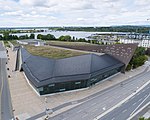Chief William Commanda Bridge
The Chief William Commanda Bridge (French: Pont Chef-William-Commanda), formerly the Prince of Wales Bridge, is a disused rail bridge in Canada, which spans the Ottawa River between Ottawa, Ontario and Gatineau, Quebec. It connected with the Bytown and Prescott Railway line just west of Lebreton Flats, and crosses the south channel of the river to Lemieux Island at the edge of Nepean Bay; it then continues across the northern channel into Quebec. Operated by the Canadian Pacific Railway for most of its history, it was bought by the City of Ottawa in 2005. Plans to incorporate it as part of an interprovincial public transportation link fell through and it is currently being renovated as a multi-use bridge. It is a multi-span Pratt truss bridge, consisting of six equal spans over the south channel, and seven spans over the north channel; the second-last span, proceeding northward, is longer by a factor of about 1.7.
Excerpt from the Wikipedia article Chief William Commanda Bridge (License: CC BY-SA 3.0, Authors).Chief William Commanda Bridge
Onigam Street, (Old) Ottawa Kitchissippi
Geographical coordinates (GPS) Address Nearby Places Show on map
Geographical coordinates (GPS)
| Latitude | Longitude |
|---|---|
| N 45.415555555556 ° | E -75.727777777778 ° |
Address
Lemieux Island Water Purification Plant
Onigam Street
K1Y 2C5 (Old) Ottawa, Kitchissippi
Ontario, Canada
Open on Google Maps











